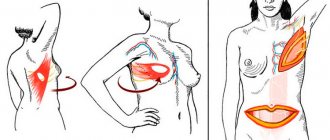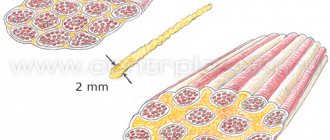Is breast surgery worth it, what problems will it solve?
Women turn to a surgeon in an effort to achieve an ideal appearance. The operation will help:
- eliminate sagging;
- remove asymmetry;
- create a “new” breast after a mastectomy or injury;
- neutralize the consequences of pregnancy and feeding;
- adjust volume for micro- and macromastia.
Thirteen common myths about mammoplasty
Misconception 1: Mammoplasty increases the risk of developing cancer
As a result of studies conducted at the beginning of the 2000s, it was found that mammoplasty and implants do not provoke the development of malignant and benign neoplasms.
The etiology of cancer has not yet been established. One can only guess where the legs of such myths come from. The fact is that the mammary gland looks like a bunch of grapes and consists of many seals. Using palpation, a mammologist cannot always detect small tumors. After plastic surgery, a woman’s breasts stretch and the gland can be easily felt. During a routine examination, a tumor is diagnosed that was simply not noticed 2-3 months ago. It is safe to say that mammoplasty has nothing to do with it.
Misconception 2: Silicone is so harmful and dangerous that even cosmetic companies have abandoned it.
The silicone is placed in a special inert shell, so it does not come into contact with surrounding tissues. Breast endoprostheses undergo serious testing in leading laboratories and medical centers, where they are tested for strength and elasticity. If the shell loses its integrity, the silicone filler will leak out, but medical silicone, a purified and sterile body, will be able to separate itself from the leaked silicone by forming granulation.
In the early 90s, the US Food and Drug Administration recognized silicone as hazardous to life and health. A few years later, the department rehabilitated silicone implants and even began recommending mammoplasty to women with a genetic predisposition to cancer. Surgery using silicone is no more dangerous than dental treatment.
Misconception 3: Plastic surgery always means scars
In 30% of cases, traces of plastic surgery cannot be detected on the skin of patients. For most women, tissue excision leaves barely noticeable incisions around the nipples and areolas. Scars under the breasts and in the armpit area are almost impossible to detect. In addition, aesthetic medicine clinics offer effective ways to correct scar tissue. When choosing a method for installing implants, you should proceed from the indications and skill of the surgeon. If a doctor practices axiolar access, then it is better to resort to this technique. The scar around the areola is easily corrected by applying tattooing.
Misconception 4: Mammoplasty is incompatible with breastfeeding and childbearing
The installed implant does not injure the mammary glands. Women who decide to undergo mammoplasty give birth to healthy children and breastfeed them. The operation is not an obstacle to childbearing and breastfeeding.
Misconception 5: Ladies who have had breast enlargement are contraindicated from flying.
An absurd assumption that contradicts the laws of physics. The implant is located in the internal environment of the human body. External pressure has virtually no effect on internal organs and systems. Abnormally high pressure is more likely to affect the vascular system and the eardrum. The endoprosthesis can withstand a fall from a height and a pressure of almost 100 kg per sq.cm. Mammoplasty and other operations to change appearance are not a contraindication to air travel.
Misconception 6: Mammoplasty is visible to the naked eye. Silicone breasts are hard and cold.
An ignorant person who has very vague ideas about mammology is unlikely to suspect a trick. As for temperature, the chest is as warm to the touch as the rest of the body. A well-performed operation is noticeable only to professionals.
Misconception 7: Mammoplasty allows you to become the owner of a sixth breast size
Before performing mammoplasty, the doctor agrees with the patient on the size of future endoprostheses. The plastic surgeon takes into account anatomical and physiological features, for example, the volume of the chest, as well as the condition of the skin. The manufacturers themselves do not make them larger than eight hundred ml.
No more than one percent of women decide to become the owner of an impressive size. Women who decide to undergo mammoplasty choose medium implants, the volume of which does not exceed three hundred ml.
Misconception 8: After 45 years, there is no point in going to the plastic surgeon's table. Surgeries are even dangerous at this age
Patients who have undergone a lift and corrected the shape of their breasts admit that they begin to feel desirable and more attractive. Indeed, after forty, the skin loses its elasticity, and the number of collagen fibers decreases. But age-related changes are not a contraindication to mammoplasty.
Misconception 9: Why do you need surgery when there are safer ways to enlarge your breasts, such as exercise, injections, gels, serums and cabbage. Mammoplasty is too expensive.
If you exercise regularly, you can increase and develop muscle tissue in the chest area. The mammary gland will move forward slightly, but will not become larger. Hyaluronate injections are an effective, but very expensive method. To enlarge your breasts you will need about two hundred ml of hyaluronic acid. If you are familiar with the prices for injection facial correction, then you understand perfectly well how much the procedure will cost: one ml of hyaluronic acid costs about 15 thousand rubles!
In addition, hyaluronic acid dissolves over time. Are you sure you want to spend several million rubles and get a temporary effect? Lipofilling, during which one’s own adipose tissue is transplanted from one area to another, is not always feasible due to physiological factors.
Women with miniature breasts have an asthenic body type. How to find the excess adipose tissue necessary for contouring on a thin and slender body? The only conservative method of breast enlargement that provides a guaranteed result is taking hormonal drugs. However, hormone therapy has many contraindications and side effects.
Breasts enlarge naturally in pregnant and lactating women. Do not forget about the proportions and parameters of the figure: a wasp waist and moderately rounded hips will emphasize even a small bust. As for the price, mammoplasty will cost 200-300 thousand rubles.
Misconception 10: The shape of silicone implants is very different from the natural one. The artificial breasts are too round and ball-like.
Depends on the physiological characteristics of the body. Under a thin translucent top, all the outlines are clearly visible, but under a thick sweater it is impossible to see anything. Same thing with breast implants. If endoprostheses of suitable size are installed under a sufficiently thick gland, then others are unlikely to notice the foreign body. Huge implants on a thin body resemble beach volleyballs. Such a bust can be seen on actresses with a provocative appearance, starring in films marked 18+. Unfortunately, even correctly installed endoprostheses become very noticeable over time. This is due to the loss of adipose tissue above the implants (blood vessels are deformed during surgery) and below them (subcutaneous fat atrophies due to the large weight of the endoprostheses).
Misconception 11: Women want to please men, so they rush to make an appointment with a plastic surgeon. All expenses fall on the shoulders of the husbands.
Many women prefer to come to consultations with their spouses. Most men are categorically against the scalpel and in every possible way dissuade their other halves from plastic surgery. Finding themselves in a room where implants of different sizes and “styles” are presented, husbands literally fall out of reality: they carry out all kinds of manipulations with silicone products, touching and weighing them.
If the patient has finally decided that she needs plastic surgery, then the man will not influence her decision in any way. In the 21st century, a woman is not only a homemaker, but also a full member of society. Ladies occupy leadership positions, travel, go to the gym, and visit beauty salons. Women are able to pay for the services of a plastic surgeon on their own. Representatives of the fair sex make an appointment in 3 cases:
- after breastfeeding, when the breasts sag and become less firm;
- there is obvious asymmetry of the mammary glands;
- the girl has breast size one or zero.
Before contacting an aesthetic medicine clinic, carefully examine your own body. If you weigh less than fifty kilograms and have a narrow chest, then you are unlikely to need the notorious “C”. Surgery is still a risk and stress for the body.
Misconception 12: Endoprostheses have a limited shelf life. In 10-15 years they will have to be replaced.
Patients with enlarged breasts may have indications for repeat surgery. The implant itself will not become unusable. Surgery may be necessary in case of changes in the shape of the mammary gland, its enlargement, reduction under the influence of hormonal drugs, changes in body weight and stretching of the skin. No one has also canceled the law of universal gravitation. With age, natural or silicone breasts will definitely sag. After 10-15 years, half of the patients undergo correction. Older women who have never been on the operating table of a plastic surgeon also often cannot do without mammoplasty. Plastic surgery allows you to preserve youth and beauty.
Misconception 13: The plastic surgery craze is just a fashion trend. In less than ten years, models with slim physiques will return to fashion.
The plastic surgery industry continues to gain momentum. Women, having seen enough of curvy beauties on Instagram, began to storm aesthetic medicine clinics. But this trend did not appear today or yesterday. Women have always wanted to attract men's gaze and show off deep cleavage. Several decades ago, breasts were enlarged with glass balls, foam rubber and paraffin. Modern plastic appeared in the middle of the last century. Interest in mammoplasty is not decreasing, but, on the contrary, increasing.
Every year in the United States of America, about three hundred thousand women undergo plastic surgery. This is the population of a small provincial town!
However, trends are constantly changing: in the early nineties, patients burst into doctors' offices with a photograph of Pamela Anderson, a few years ago everyone wanted to insert teardrop-shaped implants, today women prefer small and firm breasts.
Is it dangerous to have breast surgery: myths and facts
Many women have a misconception about what breast surgery is, because various myths go hand in hand with this intervention.
Myth #1: You can't breastfeed with implants.
Endoprostheses are installed under the pectoral muscle or mammary gland without affecting the tissues responsible for milk production.
Myth No. 2: An implant changes the composition of milk
Modern dentures have a safe filler, but even this cannot leak, thanks to a barrier shell of 1-3 layers.
Myth #3: Surgery leaves unsightly scars.
The incision is made so that the scar is located in the natural folds of the skin or along the line of the areola. After about 6-8 months it becomes almost invisible.
Myth #4: There is at least a 50% risk of contracture.
This problem has been practically solved by modern textured implants, the capsule around which is formed thin. In addition, in the postoperative period, it is mandatory to wear compression garments, which will prevent displacement.
Myth #5: Your breasts will lose sensitivity.
Yes, this can happen, but for a period of 1 to 3 months. Then sensitivity will be restored.
Myth No. 6: surgery provokes cancer
There are no carcinogens in the implants, and it is also well established that mammoplasty does not increase the risk of cancer.
Myth #7: An implant can burst during air travel or underwater.
An endoprosthesis can burst only from a puncture. When tested during production, these products can withstand pressures of several hundredweight.
How it's done
Before making a decision, you need to clearly understand what this procedure is and how it is performed.
First, a woman needs to undergo an examination with consultation from various specialists and undergo a series of tests. Diseases such as diabetes, oncology, mastopathy, hypertension and varicose veins are an absolute ban on surgery.
Having overcome this stage and received permission, the woman will have to decide on the size and shape of the implant. Drop-shaped samples with a volume of 200 ml look most natural, which allows you to make your breasts one and a half times larger. Science does not stand still and modern implants are highly reliable; the most common is considered to be a filler in the form of a highly responsive silicone gel, which is durable, has excellent shape memory and is soft.
The operation itself is performed under general anesthesia for about 2-3 hours. All details of the procedure, namely the location of the incision and location, are discussed in advance.
What risks might this operation have?
Any surgical procedure increases the risk of sudden death from myocardial infarction, stroke, or thromboembolism during or immediately after surgery. But, fortunately, such complications are extremely rare. And in our clinic there is all the modern resuscitation and anesthesiology equipment that minimizes these risks to almost zero.
Some of the risks and complications associated with breast augmentation are:
- Painful mammary glands
- Inflammation of the mammary gland
- The sensation in the chest and nipples may temporarily change or become more or less pronounced
- Implant rupture
- Bleeding
- Fluid accumulation (seroma)
A specific complication of this operation is capsular contracture - in which a thick capsule is formed around the implant. Which can deform the mammary gland, or make it extremely painful and dense. During your consultation, the surgeon will tell you in detail about this complication and how to avoid it.
In addition, even cosmetic stitches can become red, thick and painful, or, conversely, flat and wide. This may lead to repeat surgery to remove such scars.
Silicone gel implants
These implants are less likely to wrinkle than saline implants. The polyurethane-coated type is said to reduce the risk of implant rotation or scar tissue affecting the shape of the implant.
However, if a soft gel silicone implant ruptures, the silicone can penetrate into the breast, causing silicone granulomas. The implant will need to be removed if it ruptures. Polyurethane-coated implants may also cause a temporary allergic reaction.
While new silicone implants are less likely to leak into the breast if they rupture, it is difficult to determine when this will happen. The NT-Medicine Clinic and our plastic surgeons recommend magnetic resonance imaging (MRI) to detect implant ruptures 3 years after their placement, and then every 2 years thereafter.
Breast reduction.
Breast reduction surgery is called reduction. There are many methods for performing it, which differ mainly in the shape and position of the incisions on the mammary gland. But if during endoprosthetics one small incision is made, then during reduction the incisions are quite large and as a result scars remain, which over time can stretch under the own weight of the breast if the patient does not follow certain recommendations. In addition, after such an operation, loss of the ability to lactation is possible, since many milk ducts are removed. And therefore (if there is no gigantomastia), surgeons try to dissuade women from reduction, especially those who have not given birth.
Too big breasts. What to do?
Other women are tormented by the exact opposite problem: nature has endowed them too generously - with a chic, lush bust. True, some of them suffer to a greater extent not because it causes them some kind of inconvenience (for example, when playing sports), but rather because of... the stronger sex. It seems to some that their breasts “repel” men, to others, on the contrary, that they only look at a large bust... But besides psychological reasons, there are, of course, others. It is difficult to choose clothes and underwear - a lot of things have to be made to order. But the most serious problems are pain in the spine, skeletal deformation, and breathing problems.
What might a patient be dissatisfied with after surgery?
Although most breast implant surgeries go smoothly, some patients, especially those operated on by novice surgeons or poorly equipped clinics, may be dissatisfied with the results.
The following complications occur in at least 5% percent of breast implant patients at any time after surgery. Some of these complications will require treatment or additional surgery to correct them:
- asymmetry regarding the shape, size or level of the breast
- pain in the nipple or breast area
- breast tissue atrophy, in which breast tissue loses its substance
- breast skin thins and shrinks
- calcium deposits that form as hard lumps under the skin around the implant
- The scar tissue around the implant shrinks and the breast thickens
- deformity of the chest wall or rib cage
- deflation due to leak, rupture or cut
- the incision is not healing properly
- breaking down the skin to reveal the breast implant through the skin
- collection of blood near the surgical site, causing painful swelling and bruising
- tissue or implant is damaged as a result of surgery
- infection such as toxic shock syndrome
- swollen lymph nodes
- incorrectly installed breast implant
- death of the skin or tissue around the breast, usually due to infection
- hole or rupture in the implant
- accumulation of fluid around the implant, which can cause pain, swelling and bruising
Therefore, it is extremely important to choose a clinic and surgeon that is fully equipped and has experience in dealing with all possible complications.
Decreased nipple sensitivity after breast augmentation
Every woman experiences nipple numbness or hypersensitivity after surgery. Such syndromes are caused by damage to the small nerves running along the chest wall and leading to the nipples. The normal state returns within three to six months. In rare cases, restoration of sensitivity takes 1-2 years.
Experts recommend that women massage and stroke the sides of their breasts and ribs to restore sensation. Silicone nipple covers are necessary for hypersensitivity to reduce friction between the breast and clothing. After tingling and itching of the nipples, you can determine that the general condition is normalizing.
Can implants provoke the development of cancer?
The answer can be absolutely unequivocal, and it has long been scientifically proven that implants do not cause or provoke any cancer. Silicone is a completely inert material that is used not only in plastic surgery, but also in many other medical fields, for example, for the manufacture of vascular prostheses. The duration of observation of medical devices containing silicone has been more than 50 years. And this experience allows us to say for sure that implants do not cause cancer. Implants have been approved and are currently used both for delayed reconstruction of the mammary glands after cancer, and even immediately after tumor removal. Moreover, the degree of fibrocystic mastopathy, and this is one of the conditions when a benign process can develop into a disease, may even decrease after implantation. This is due to moderate compression of the cysts after implantation in the glands. It is worth noting another important aspect: implants do not complicate or limit the possibility of subsequent examination of the mammary glands, i.e. Ultrasound or mammography is possible and is as informative as in patients without implants. On the contrary, after breast augmentation, the habit of regularly going to see a breast surgeon is often “instilled,” which is something rarely done before surgery.
Implants with saline solution
These implants contain a salt water saline solution that can be safely absorbed or released by the body if the implant ruptures.
Since the saline solution will leak out of the shell, it is much easier to determine whether the product has ruptured, since the mammary gland will quickly lose its volume. Because they are less durable than silicone implants, these implants are thought to be more prone to wrinkling. Recently, most plastic surgeons have stopped using them.
Complications in the early postoperative period
The most common early complications of breast augmentation surgery include:
- Hematomas and seromas. They develop as a result of accumulation of blood or wound discharge in the implant pocket. These complications are usually accompanied by severe symptoms, so they are not difficult to diagnose. Small hematomas and seromas go away on their own. In some cases, their puncture may be required. If you do not consult a doctor in time, such complications can lead to the breast becoming asymmetrical and painful, requiring removal of the endoprosthesis and its reinstallation.
- Infectious complications. When pathogens enter a wound, both pronounced and subclinical forms of infectious diseases can develop. They are usually manifested by fever, weakness, fatigue, and muscle pain. Treatment is usually conservative and consists of prescribing antibacterial drugs.









